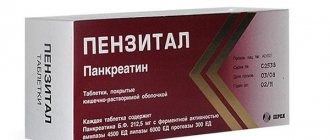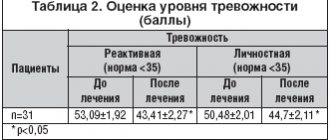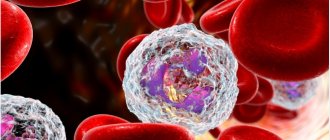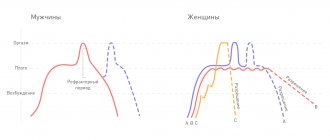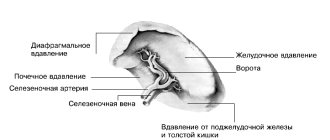Is it possible to teach our brain to artificially produce the “happiness hormone” - serotonin? This task is not easy, but feasible, because managing the delicate hormonal balance is within the power of any person. You just need to want it - and literally in 5 minutes you will be in a great mood and ready to “move mountains.” Hormones of pleasure and happiness will help you in this endeavor:
- serotonin - it is called the hormone of happiness, which gives a feeling of euphoria;
- dopamine – it is responsible for pleasure and reinforces positive experiences;
- Oxytocin - it gives rise to feelings such as love, tenderness and affection.
Most often, this “trinity” works in tandem, forming all our positive emotions. But now we will talk specifically about serotonin. Many people already know the name of this hormone of joy and happiness. But not everyone understands how it works. And even fewer people know how to regulate the level of this hormone in the body.
How to learn to manage serotonin?
This neurotransmitter, which regulates our mood, is not as simple as it might seem at first glance. Surely you think that serotonin is another hormone that is produced in the human brain. This is true, but only partly. Here are the hard facts: 95% of serotonin is produced in the intestines. And only 5% is in the brain.
So really, the path to our happiness lies through the stomach? And this is not entirely true. Serotonin is a complex chemical substance, a derivative of the amino acid tryptophan and, concurrently, the manager of our brain. This hormone is responsible for a wide range of processes both in the brain itself and throughout the human body:
- Serotonin in the brain helps nerve cells communicate better.
- The joy hormone affects sleep and appetite, muscle condition and body function, character and mood.
- The most important neurotransmitter affects cognitive functions (attention, memory, communication, etc.).
- Serotonin is responsible for normal blood clotting and stable functioning of the circulatory system.
- The joy hormone helps us experience interest and attraction to the opposite sex.
Call an ambulance urgently!
It is important to treat abdominal pain carefully. If your stomach hurts unbearably, you should under no circumstances hesitate. A doctor's examination will help avoid serious complications.
If the following symptoms appear along with abdominal pain, you should urgently call a doctor:
- Blood clots or blackness in the stool.
- Severe pain accompanied by nausea or diarrhea.
- Poor health caused by pressure.
- Hard belly.
- Heat.
- The skin takes on a yellowish tint.
- Dizziness, general weakness.
- Spread of pain to the lower back, shoulders or lower abdomen.
- Increased heart rate.
- There is a sharp grip in the stomach, the pain radiates to the area between the shoulder blades.
Pregnant women and patients who have recently suffered an injury need to monitor their condition especially carefully.
What happens if serotonin levels are disrupted?
Very often we hear about how low levels of the happiness hormone are bad. But the human body is harmed not only by a deficiency, but also by an excess of serotonin. In other words, any disruption in the production of this neurotransmitter provokes a whole list of negative consequences and conditions:
- bad mood and chronic depression;
- a sharp decrease in sexual desire;
- problems with digestion and sleep;
- cravings for sweets and weight gain;
- decreased activity.
The problems listed above are just the tip of the iceberg. The work of serotonin, based on two substances - the amino acid tryptophan and its derivative 5-hydroxytryptophan, is very complex. Sometimes the hormonal imbalance is so pronounced that specialists have no choice but to prescribe antidepressants - serotonin reuptake inhibitors.
Signs of Serotonin Deficiency
The following signs may indicate insufficient production of this necessary inhibitor:
- Fast fatiguability;
- Emotional imbalance, vulnerability;
- Regularly recurring headaches;
- Depression;
- Decreased or, conversely, excess appetite;
- Insomnia;
- Inhibited, disordered thinking;
- Memory impairment;
- Craving for alcohol.
An experiment performed on monkeys demonstrated that serotonin affects not only character and behavior, but also social status. Scientists chose from the pack the most cowardly, but at the same time, prone to impulsive manifestations of aggression, male. Naturally, such a primate could not enjoy the respect of his fellow tribesmen. But after receiving a dose of the hormone, his posture straightened, and his reactions became much more confident and calm. Thus, the former omega turned into a worthy competitor for the leader of the pack.
A similarly low level of serotonin production is observed in the group most susceptible to neuroses and depressive states. Physiological support and work with a psychologist help these patients become more morally stable and increase their importance in society.
But is it worth using “heavy artillery” right away?
We know that antidepressants work quickly. But we also know that they have a lot of disadvantages, the most important of which are addiction and various side effects that can seriously undermine already weakened health. The image below shows how hard antidepressants work. It’s worth thinking about whether such radical measures are necessary???
Is there a safe alternative to pills? Eat. This is the right way of life and the ability to look at the world positively. The “recipe” for your happiness will not consist of a set of drugs, but of completely different components:
- Nutrition. Healthy foods contain everything you need to produce the hormone serotonin in sufficient quantities. Give up fast carbohydrates and junk food in favor of healthy carbohydrates and foods containing tryptophan. Serotonin “grows” on variety: grains and cereals, vegetables and fruits, eggs and dairy products, lean meat and fatty fish, nuts, seeds and dried fruits.
The image shows foods rich in tryptophan.
- Movement. Scientists have repeatedly proven that any physical activity quickly (literally in 30-40 minutes) increases the level of serotonin in the blood. Dancing, walking, swimming, cycling, morning jogging - there are many activities, you don’t have to go to the gym. But there is one “but”: you need to be active constantly, and not from time to time.
- Sleep and meditation. A happy person knows how to “switch off” in time and let go of negativity from his life. Sometimes this is difficult to do. And then meditation and healthy sleep come to the rescue, during which the level of the happiness hormone also increases. Train yourself to go to bed and get up at the same time - and you will not have problems with serotonin.
- More sun. In our climate, sunny days are a rare occurrence. But even on a cloudy day, our skin still receives its portion of ultraviolet radiation. This means that the answer to the question “how to increase serotonin” is simple: walk more often. Walking will give the body maximum happiness hormone and beneficial vitamin D.
- Omega-3. It is difficult for us to maintain an optimal level of essential polyunsaturated fatty acids, which are found in excess only in the meat of fatty fish from the northern seas. But now there is already a worthy alternative - dietary supplement complexes with Omega-3. Such supplements are a real “delicacy” for the brain and prevent a number of diseases.
- Pleasure. Serotonin is responsible for pleasure and enjoyment. How can you get more of these emotions? There are a lot of ideas: for example, falling in love, finding a new exciting hobby, meeting friends more often, spending more time with loved ones. The more bright emotions and positivity there are in your life, the higher the level of the happiness hormone will be.
- "Helpers." Unfortunately, even with proper nutrition, it is not possible to obtain from food 100% of the substances necessary to nourish the brain and body. And then “serotonin in tablets” comes to the rescue. These are special plant vitamin complexes that help the happiness hormone be produced correctly and in the required volume.
About the importance of a healthy lifestyle
The statement that physical activity and walks in the fresh air lead to happiness is not an allegory, as it turns out, but a scientifically proven fact. Bright sunlight and movement are known to significantly stimulate serotonin production, so daytime walks are a great remedy. In addition, fresh air contains oxygen. You can walk or do simple exercises in the park, and if you are very enthusiastic, even join a gym or sports section.
How do vitamins for a good mood work?
Unlike antidepressants, which inhibit serotonin reuptake, plant-based vitamins act differently—more gently. They bring all neurotransmitters into balance and help the happiness hormone be produced in the right quantity without causing serious harm to the human body:
- fight fatigue and irritability;
- increase memory, attention and concentration;
- eliminate insomnia and other sleep disorders;
- protect against depression and nervous disorders;
- restore interest in life and normalize appetite.
Constant stress at work and at home does not allow you to always be at the peak of activity. But now this problem can be easily solved: just one capsule of herbal vitamins a day - and it will be much easier for you to cope with the challenges that this world has prepared for you. Forgetfulness, absent-mindedness and apathy will be replaced by cheerfulness and a positive mood.
The role of serotonin in the physiology and pathology of the gastrointestinal tract
The prevalence of diseases of the gastrointestinal tract (GIT) and unsatisfactory treatment results [1, 4] determine the relevance of fundamental research in gastroenterology and are one of the pressing problems of modern medicine. More than 60–70% of the population suffers from various gastrointestinal diseases, 13–17% of them require hospitalization; in some cases, diseases of the digestive system are accompanied by the development of serious complications, requiring urgent care and disabling operations [5]. It should be noted that most inflammatory diseases of the gastrointestinal tract are associated with dysfunction of the innervation apparatus, in particular the intramural ganglia, and the local enterochromaffin system of humoral regulation [7, 8]. An important element of these organ-associated systems is serotonin. Today, the role of this regulator in the pathogenesis of Crohn’s disease, ulcerative colitis, irritable bowel syndrome (IBS), gastroesophageal reflux disease (GERD), etc. has been proven [4, 5, 8, 32]. However, only a few studies address the participation of serotonin-mediated mechanisms in the pathogenesis of peptic ulcer disease, although its development is largely associated with the restructuring of the local regulatory system, the adequacy of which depends on the state of the diffuse endocrine system (DES) [2, 16, 17, 19]. It is also important to establish the role of this regulator in the implementation of compensatory-adaptive and pathological processes during ulcerogenesis in the gastroduodenal zone. This motive determined the purpose of this review. Serotonin (5-hydroxytryptophan - 5-HT) is used for regulation and signaling in both the brain and visceral organ systems. For example, in the brain, serotonergic neurons are located in the median raphe nuclei. Descending projections from the raphe nuclei influence the spinal cord and brainstem, where they are involved in the central regulation of pain and pathological pain syndrome [20, 21, 24]. In contrast, ascending projections are directed to areas with an integrative function, involved in the regulation of mood, sleep, sexual and eating behavior, largely determining the overall quality of life. However, most serotonin is produced outside the central nervous system, where it is an important neurotransmitter, hormone, and intercellular messenger [25]. The source of serotonin synthesis in the visceral organs is mast cells, blood basophils, enterochromaffin cells and gastrointestinal neurons [21–23]. Moreover, 60–90% of serotonin in the human body is produced in the gastrointestinal tract, and more than 90% of serotonin in the gastrointestinal tract is secreted by enterochromaffin cells [33]. When analyzing the pathogenesis of atopic/allergic diseases, it is also important to take into account mast cells that release serotonin after the binding of allergens to IgE [29]. Secreted serotonin accumulates in platelets and is released upon aggregation. It is natural that the level of this amine increases sharply when stimulating the aggregation activity of platelets and during inflammation [20-25]. Serotonin plays an important role in the regulation of gastrointestinal motility, the secretion of hydrochloric acid, the transport of chlorine in the duodenal epithelium, and the secretion of bicarbonates in it. In addition, serotonin is a vasoactive agent, a proplatelet agent, and a powerful immunomodulator [12, 13]. 5-HT can regulate processes in leukocytes such as migration, phagocytosis, and cytokine secretion [15]. In the duodenum, under the influence of peptic factors (acid, bile, enzymes), there is an increase in the production of serotonin, which provides an acute secretogenic effect and increased motility [3, 6, 7]. However, the role of 5-HT in the pathogenesis of ulcerogenesis and complications of gastric and duodenal ulcers has been poorly studied [24]. In many ways, the analysis of the mechanisms of this phenomenon is complicated by the multifactorial regulation of the synthesis and secretion of serotonin, a wide range of target cells and numerous receptors for 5-HT, association with the blood coagulation system and the implementation of an acute inflammatory response of the body to damage [31, 33, 41].
Sources and mechanisms of serotonin production in the gastrointestinal tract
The plasma level of 5-HT depends on a number of parameters: the availability of the substrate for the synthesis of 5-HT, the rate of synthesis and intensity of secretion of the latter, the severity of its degradation and utilization by platelets, and release from platelets upon their stimulation [23, 30]. The effects of serotonin can be modified by a combination of different types of receptors and their desensitization [9, 10, 15]. The substrate for the synthesis of 5-HT is the amino acid tryptophan, the concentration of which can decrease in a number of pathological conditions, for example, trauma, respiratory distress syndrome in adults, autoimmune diseases, as well as activation of indoleamine 2 3-dioxygenase (IDO) [37]. Increased activity of the latter not only limits the level of serotonin, but also affects the functional system of cholinergic regulation associated with 5-HT [27, 28, 31]. Thus, increased degradation of tryptophan leads to an increase in the level of kynurenic acid, which is an antagonist of central and peripheral nicotinic cholinergic receptors. Thus, a decrease in tryptophan levels due to IDO activation leads to a parallel decrease in 5-HT content and the effects of acetylcholine (ACh), mediated by stimulation of nicotinic (Nα7) cholinergic receptors [9]. Experimental studies have confirmed this position, showing that an increase in the level of kynurenic acid is accompanied by a decrease in signaling through the Nα7 type of cholinergic receptors in the brain of mice and is reflected in the characteristics of the inflammatory response [28]. In the gastrointestinal tract, 5-HT is synthesized by enterochromaffin cells, enteric neurons and released from circulating platelets [4, 5]. Serotonin is synthesized through the activation of two different tryptophan hydroxylases, TpH1 and TpH2, which are found in endocrine cells and neurons, respectively [30, 37]. In the inflammatory zone, activation of platelets with the participation of platelet activating factor, a component of the complement system - anaphylaxin C5a and IgE-containing immune complexes is accompanied by platelet aggregation and the release of 5-HT. C5a also activates mast cells and releases 5-HT from them [26]. In endocrine EC cells, some of which are open type, serotonin production is stimulated by a decrease in lumenal pH [35]. This mechanism underlies the protective effect of serotonin in conditions of increased HCl secretion, since the increase in its production is accompanied by the inclusion of a motor reflex that accelerates evacuation, increased secretion of mucus and bicarbonates [19, 22 26]. The latter effect is due to an increase in the level of cytoplasmic cAMP through 5-HT4 receptors [10, 16]. The result of the activation of the signaling system is an increase in intestinal secretion of chlorine and bicarbonates, although an equally important target of serotonin in the plasmalemma of enterocytes is the Na+–Ca2+ exchanger. Interestingly, this effect of 5-HT is similar to that of carbachol, which confirms the synergistic functioning of ACh and 5-HT in the gastrointestinal tract. This is partly due to the presence of muscarinic and nicotinic cholinergic receptors on EC cells, the stimulation of which causes an increase in the release of 5-HT from endocrine cells. Accordingly, activation of parasympathetic neurons increases plasma concentrations of free 5-HT. Finally, the most important factor stimulating the production of serotonin in EC cells is the loss of their contacts with nerve endings. In this regard, it should be noted that the “EC-cell-nerve endings” contacts (both afferent and efferent), unlike neuromuscular synapses, are unstable. Their high lability is determined by the pronounced kinetics of epithelial cells of the intestine and stomach and is associated with constant cell migration. Increased secretion of 5-HT upon loss of contact with the nerve ending is considered a compensatory mechanism, since serotonin stimulates the growth of nerve fibers and restoration of innervation [14]. A consequence of the release of 5-HT from the endocrine cells of the intestinal mucosa (IM) is the activation of 5-HT receptors on vagal afferents, which ensures a flexible system of reciprocal relationships between ACh and 5-HT. In addition to EC cells, serotonergic intramural neurons are an important source of serotonin in the gastrointestinal tract. They constitute only a small part of the total number of intramural neurons of the gastrointestinal tract, but this type of cell divergently innervates other neurons of the intramural plexuses [11]. Most of them are represented by cholinergic neurocytes, which form numerous synaptic connections far from the neuron body. The abundance of cholinergic synapses in the wall of the gastrointestinal tract, in which ACh is released (for example, upon stimulation of 5-HT4 receptors), determines the important role of serotonin in synchronizing the motility of different parts of the gastrointestinal tract [11]. This probably explains the high effectiveness of the use of 5-HT receptor agonists in the treatment of GERD, IBS, etc. [29] An equally important factor is the rate of inactivation of active 5-HT. The classic feedback loop in the parasympathetic nervous system is based on the mechanisms of enzyme-mediated catabolism of the signaling molecule. Thus, serotonin is catabolized by monoamine oxidase, and in the intestine by transferases and other enzymes [7, 8-10]. But all these enzymes are intracellular molecules that are not involved in the completion of serotonin-mediated signaling events [21]. Basically, serotonin inactivation occurs due to its uptake by cells using transporters, and this reuptake is characteristic of both serotonin-secreting cells and neighboring cells, such as enterocytes [21, 26]. The possibility of utilization of 5-HT in monocytes, macrophages, dendritic cells (DCs) and lymphocytes through activation of the 5-HT uptake system, realized through the serotonin reuptake transporter (SERT), has also been established. The presented data on metabolic disorders and the effects of 5-HT in the gastrointestinal tract in a number of diseases require a more detailed analysis of the mechanisms of its influence.
Targets and effects of serotonin in the gastrointestinal tract
Disturbances in serotonin metabolism are indicated in various inflammatory diseases of the gastrointestinal tract. For example, in untreated celiac disease, an increase in the number of EC cells and a significant increase in plasma serotonin levels were noted in the duodenum [15]. Moreover, the peaks in the rise in serotonin levels correlated with attacks of dyspepsia, confirming the role of this hormone in the pathogenesis and clinical manifestation of this pathology. In ulcerative colitis, a decrease in the number of EC cells, the level of serotonin in CO and mRNA encoding TpH-1 and SERT was detected, with a significant decrease in SERT immunoreactivity [18]. The opposite situation – increased immunoreactivity, especially in the neurons of the myenteric plexus, was noted in Crohn’s disease [34]. In the diarrheal form of IBS, a violation of the expression of serotonin mRNA in CO, TpH1 and SERT was established. A relationship has been shown between the form of IBS and the level of serotonin: a decrease in the content of serotonin and enzymes of its metabolism in the form associated with constipation, and an increase in the diarrheal form [17]. The above facts, however, do not bring us closer to understanding the pathogenetic mechanisms of the development of different variants of gastrointestinal pathology. And when solving this issue, it is impossible to do without analyzing the mechanisms of influence of 5-HT on various targets in the mucous membrane. The targets of serotonin in the gastrointestinal tract are: – integumentary epithelium – enterocytes that express 5-HT receptors on the basolateral surface [20]; – nerve endings of extramural nerves that provide the transmission of sensory information to the central nervous system. Increased stimulation is associated with feelings of nausea and discomfort [19]; – projections of intramural nerve afferents into the SO (IPANs), forming direct connections with EC cells, which ensures the activation of protective reflexes [8]; – afferents of the submucosal intramural plexus, which initiate peristalsis and the secretory reflex. Serotonin stimulation of primary afferents causes activation of intrinsic neurons and stimulation of the peristaltic reflex [11]; – afferents of intramural neurons in the muscularis propria, which initiate pronounced contractions. Serotonin, secreted by neurons of the myenteric plexus, regulates fast and slow excitatory transmission and is involved in the regulation of gastrointestinal motility [8, 16]; – cholinergic neurons (bodies and efferents) mainly of the intermuscular plexus. Their stimulation by serotonin causes an increase in neuromuscular cholinergic transmission [11]; – smooth myocytes of the muscular plate of the mucous and muscular membranes [13]; – smooth myocytes of mucosal and submucosal vessels, realizing the vasoactive properties of serotonin [11]; – peripheral blood leukocytes and cells that form intestinal-associated lymphoid tissue (KALT) [12, 22]. Thanks to such a variety of targets, serotonin in the gastrointestinal tract functions not only as a neurotransmitter, but also as a paracrine messenger that determines intertissue and intercellular cooperation in the mucous membrane, as well as the implementation of compensatory and adaptive reactions. A number of authors consider serotonin as a growth factor, since it enhances cell proliferation in the intestinal crypts. During ontogenesis, serotonin stimulates the development of intramural neurons, and in the postnatal period it increases the survival of neurons and their plasticity due to stimulation of 5-HT4 receptors. It should be noted that serotonin is present in neurons and EC cells at the earliest stages of gastrointestinal development [14]. In this regard, it is assumed that the expression of serotonin determines the number and types of neurons, as well as the characteristics of the DES of the intestinal mucosa in the future. By maintaining the viability of neurons, serotonin maintains the resistance of the intramural system of neurons to extreme factors and prevents aging. Thus, in the gastrointestinal tract, 5-HT has a variety of effects on intramural neurons, extrinsic afferents, enterocytes, the bloodstream and smooth muscle cells, which is due to the expression of different 5-HT receptors that regulate motility, vascular tone, secretion and ascending afferentation in the central nervous system.
Serotonin receptors in the gastrointestinal tract
The wide range of 5-HT-mediated effects is associated with the individual expression of different classes of G-protein-coupled and ionotropic receptors (5-HTR). The 5-HTR1 and 5-HTR2 classes include at least five (5-HTR1A, 5-HTR1B, 5-HTR1D, 5-HTR1E, and 5-HTR1F) and three (5-HTR2A, 5-HTR2B, and 5-HTR2C) G protein types -related receptors. Most of them are associated with Gi/o and Gq proteins. 5-HTR3 are ligand-bound cation channels that cause depolarization of the plasma membrane by activating Na+ and K+ currents [7]. 5-HTR4, 5-HTR6 and 5-HTR7 are associated with the Gs protein, which mediates the stimulation of adenylate cyclase [24]. The unique distribution of serotonin receptors in the structures of the gastrointestinal tract opens up the possibility of using selective agonists or antagonists to correct various types of disorders of the gastrointestinal tract. Thus, extramural nerves that transmit the flow of sensory information to the central nervous system are activated by 5-HTR3, which allows the use of selective antagonists (for example, ondansetron, granisetron and alosetron) to reduce serotonin-induced discomfort during chemotherapy in cancer patients [18]. Other types of receptors, including 5-HT1 and 5-HT7, stimulate IPANs, which control peristalsis and secretion. The submucosal system of IPANs is represented by cholinergic neurons that also express calcitonin gene-associated peptide (CGRP). ACh and CGRP are responsible for the fast and slow components of excitatory neurotransmission, the regulation of which is the goal of developing new drugs that correct spastic symptoms and peristalsis disorders. Stimulation of 5-HTR4 increases the release of ACh and thus enhances the amplitude of the fast excitation wave and prolongs synaptic transmission [11]. 5-HTR4 is also localized at the terminals of efferent nerves that release ACh, thereby their activation increases the release of the latter from nerve endings and stimulates intramural neurons. Due to these effects, 5-HTR4 agonists provide enhanced neuromuscular transmission, which justifies their use for the treatment of gastrointestinal pathologies associated with reduced motility (see table).
It has been established that 5-HTR4 agonists have a moderate positive effect in the treatment of patients with GERD, although they are less effective than proton pump inhibitors [16]. A number of authors have demonstrated the therapeutic potential of 5-HT4 agonists in the treatment of gastroparesis and correction of gastric “accommodation” accompanied by functional dyspepsia. In addition, 5-HTR4 agonists can relieve visceral hypersensitivity [8]. In case of gastrointestinal dysfunction, the role of serotonin reuptake inhibitors is positive, which, by prolonging the action of released serotonin, enhance its effect on targets both in the central nervous system and in the gastrointestinal tract. Tricyclic antidepressants have been shown to inhibit SERT and can simulate the functioning of the gastrointestinal tract, but also have side effects - for example, they inhibit norepinephrine and dopamine transporters [18]. Despite the effectiveness of using these drugs, it should be noted that their use is limited. At the same time, the “other side of the coin” – the immunomodulatory properties of serotonin – is absolutely not taken into account. Ignoring this fact not only limits the understanding of the role of serotonin in neuroimmunohumoral control, but can also become a “Pandora’s box” for drug correction of the mechanisms of serotonin-mediated intercytokine connections. Such effects of serotonin were first described in the study of the pathogenesis of bronchial asthma (BA). It turned out that stimulation of serotonergic receptors in monocytes, epithelial cells of the airways and lungs is accompanied by the production of proinflammatory cytokines [7]. Moreover, the direct role of 5-HT in asthma was confirmed by the relationship between the severity of the disease and serotonin levels. In addition, 5-HT plays an important role in the activation of T lymphocytes and their interaction with DCs, and has chemoattractant activity for eosinophils and mast cells [22, 28].
The role of serotonin in the implementation of nonspecific and specific immune responses
Neuroendocrine control of the immune system is provided through the hypothalamic-pituitary axis through direct efferent connections and the peptidergic sensory system in the peripheral lymphoid organs. Circulating hormones and released neurotransmitters regulate the presentation of antigens, antibody production, homing and activity of lymphocytes, proliferation and differentiation of lymphocytes, secretion of cytokines, selective activation of the T-helper type 1 or 2 response (Th1 or Th2) and, accordingly, cellular or humoral immunity [16]. During inflammation, activation of the “stress system” through stimulation of the Th2 pathway protects the body from systemic inflammation triggered by Th1-associated proinflammatory cytokines. In a number of situations, “stress hormones”, ATP and activation of the CGRP regulatory loop (substance P-histamine) can increase inflammation by activating the secretion of pro-inflammatory cytokines - interleukins (IL-1β, IL-6, IL-8, IL-18) and factor tumor necrosis α (TNF-α). An imbalance of neuro-immunoendocrine relationships can lead not only to hyperactivity of local pro-inflammatory factors, but also to disruption of activation of the feedback system - a systemic anti-inflammatory response, which is especially important in the development of complications of gastrointestinal diseases, including ulcerative bleeding [36]. Analysis of the mechanisms of regulation of the immune response leads to the idea that most chronic gastrointestinal diseases are associated with impaired resolution of the inflammatory process and the inclusion of autoimmunization mechanisms associated with disruption of intercytokine relationships. Inflammation activates the migration of various types of blood cells, including monocytes and neutrophils, recruited to the damaged area. At the same time, monocytes and their derivatives - macrophages and DCs - play an important role in the recognition and elimination of microorganisms. The binding of cytokines, biogenic amines and products secreted by microorganisms to receptors stimulates the release of cytokines and other effector molecules, the set of which determines the implementation of nonspecific defense reactions and adaptive immunity. Normally, there is a balance between secretory levels of pro-inflammatory and anti-inflammatory cytokines. The sequence of their release is considered one of the key determinants that determines the pattern of molecular and morphological events accompanying inflammation and repair. Disruption of this balance can prolong and intensify the inflammatory response and cause the development of a pathological process. In this regard, special attention is paid to the cellular mechanisms that control the level of cytokines in health and disease. Within the gastrointestinal tract, ACh and 5-HT are considered first on this list. According to the concept of the cholinergic anti-inflammatory response, the brain, through the vagus, controls the systemic inflammatory response to endotoxins and bacterial lipopolysaccharide (LPS). Vagal stimulation also limits the release of TNF-α from macrophages of the reticuloendothelial system. This effect is absent in mice with a defect in nicotinic α7 receptors and is associated with posttranscriptional regulation of cytokine expression. Activation of cholinergic control reduces the recruitment of leukocytes to the inflammatory zone [37]. It is known that in LPS-stimulated macrophages, ACh reduces the release of IL-1β, IL-6 and IL-18, but does not change the production of IL-10. The effect of 5-HT on cytokine release is more complex. In leukocytes, serotonin regulates phagocytosis, migration, production of superoxide anions, secretion of cytokines, etc. Understanding the mechanisms of serotonin’s influence on the implementation of nonspecific and specific responses of the immune system requires a detailed consideration of the cell-specific expression of 5-HT receptors. In particular, 5-HT has the opposite effect on the production of proinflammatory cytokines in neutrophils, causing a decrease in TNF-α and an increase in IL-1β in human dendritic cells, neutrophils and monocytes [24]. The production of IL-6, IL-10 and the expression of receptors for IL-1β do not depend on 5-HT. 5-HT has been shown to enhance the release of interferon γ (IFN-γ) in human NK cells, as well as the chemokine IL-16 in peripheral blood leukocytes and CD8+ T cells [12]. Thus, 5-HT may control the development of inflammation by regulating the pattern of secreted cytokines. Peripheral blood neutrophils contain 5-HT2A receptors, the activation of which is associated with stimulation of phospholipase Cβ through the Gq protein and is accompanied by an increase in Ca2+ levels (through inositol-3-phosphate - I3-P) and activation of protein kinase C [9]. Interestingly, a similar activation mechanism is also characteristic of platelets. As a result of activation of 5-HT2A receptors in platelets, secretion of granules occurs, a change in shape (due to activation of protein kinase C and the cytoskeleton), increased aggregation (progression of thrombogenesis) and increased expression of P-selectin. Probably, this phenomenon ensures the conjugate work of platelets and leukocytes in the damaged area. It is equally important that the activation of this signaling system is accompanied by stimulation of phospholipase A2 and the launch of the arachidonic acid cascade, which in platelets leads to the formation of thromboxane A2, and in neutrophils to an increase in the secretion of prostaglandins and leukotrienes. In addition, an increase in the level of intracellular Ca2+, the production of reactive oxygen species and modulation of Rho kinases leads to the activation of the family of mitogen-activated kinases - MAPK, in particular p-38MAPK, which in neutrophils determines a change in the functional response at the transcriptional level. The main result of the effect of 5-HT on neutrophils is a decrease in the expression of TNF-α with an increase in the production of IL-1β and the expression of cell adhesion molecules that potentiate the recruitment of neutrophils to the inflammatory zone. A limiting effect of 5-HT on the intensity of the respiratory burst has also been described, which is associated with a limitation in the activity of myeloperoxidase (MPO). Although, according to other authors, serotonin can be a substrate of MPO, ensuring its inactivation and catabolism [38]. Predominant expression of 5-HTR2 is also characteristic of eosinophils and mast cells, in which serotonin causes activation of the cytoskeleton and leads to increased migration [28]. Unlike neutrophils, which carry predominantly 5-HTR2A, monocytes and their derivatives (DCs and macrophages) express a wide range of 5-HT receptors. Moreover, the effects of serotonin on different representatives of this differential differ significantly (monocytes, phagocytes - macrophages and APC - DCs) [30]. Human monocytes express mRNA for the 5-HTR1E, 5-HTR2A, 5-HTR3, 5-HTR4, and 5-HTR7 serotonin receptor subtypes. The expression pattern of 5-HTR mRNA in monocytes is not altered by LPS. This is significantly different from the situation in DCs, where exposure to LPS negatively regulates the levels of 5-HTR1E and 5-HTR2A subtypes of mRNA [12], but increases the expression of 5-HTR4 and 5-HTR7 mRNA. These changes may depend on the specifics of tissue regulation.
As in neutrophils, in monocytes 5-HT inhibits the release of TNF-α. It was shown that agonists of the 1st and 3rd types of 5-HT receptors do not affect the secretion of TNF-α in unstimulated monocytes, however, the addition of 5-HT together with LPS reduced the release of TNF-α, and the half-maximal and maximum effect was obtained with concentrations of 10-5 and 10-3 M 5-HT, respectively [22]. When studying the mechanisms of the effect of 5-HT on monocytes, it was found that 5-HTR4 and 5-HTR7 are involved in the modulation of the secretion of IL-1β, IL-6 IL-8/CXCL8, IL-12p40 and TNF-α, while the 5-HTR3 subtype modulates the secretion of IL-6, IL-8/CXCL8 and IL-1β, but has no effect on the production of IL-12p40 and TNF-α. Activation of 5-HTR4 and 5-HTR7 in monocytes inhibits the production of TNF-α and IL-12, but increases the production of IL-1β, IL-8 and reduces the secretion levels of IL-12 and TNF-α [30]. Activation of 5-HTR3 in monocytes stimulates increased production of IL-1β and IL-6 [9]. Thus, most of the cytokine-modulating effects of serotonin are associated with the functioning of 5-HTR3, 5-HTR4 and 5-HTR7. These responses may contribute to the development of different inflammatory patterns, reflecting the regulatory role of serotonin in the immune system.
Analysis of serotonin receptors revealed that 5-HTR4 and 5-HTR7 are coupled via Gs to stimulation of adenylate cyclase, leading to increased intracellular cAMP levels. Indeed, there is evidence that cAMP modulates the production of IL-1β, IL-6, IL-12p40, IL-8/CXCL8 and TNF-α in other cell types. It is important to note that, unlike IL-12p70 heterodimers, IL-12p40 monomers and homodimers have an inhibitory effect on Th1, creating conditions for Th2 stimulation. Increased production of IL-12p40 under the influence of serotonin causes polarization of the immune response towards the dominance of the Th2 response, which is the most important pathogenetic event in the development of asthma and atopic pathology of the gastrointestinal tract [16]. The main role in the regulation of the immune response belongs to dendritic cells, the spectrum of which produces chemokines and cytokines precisely determines the polarization of T cells. The release of 5-HT may be important in the recruitment of monocytes and their conversion into DCs in the inflammatory zone. 5-HT is a chemoattractant for immature DCs, but does not affect the migratory activity of mature LPS-stimulated DCs, and this is associated with activation of the 5-HTR1B and 5HT2 subtypes. The use of the 5-HTR1B antagonist GR 55562 and the 5-HTR2A antagonist ketanserin showed that both receptor subtypes are involved in 5-HT-induced migration of immature DCs. However, as DCs mature, they lose the ability to respond to 5-HT via 5-HTR2A. In mature DCs, 5-HT modulates the secretion of IL-6, CXCL10, CCL22 and the polarization of the immune response through activation of the 5-HTR4 and 5-HTR7 subtypes [19]. DC maturation can be induced by external signals - for example, bacterial endotoxin, paracrine signals - an increase in the level of TNF-α and is accompanied by the expression of MHCII and costimulatory molecules. Without affecting the mechanisms of DC maturation, serotonin, however, has a number of effects on immature and mature cells of this line. It was noted that serotonin increases the migration of immature DCs, but does not affect their production of chemoattractants. In this case, immature DCs produce high levels of CCL22, which attracts predominantly Th2 class cells, but low levels of CXCL10, which is a chemoattractant for Th1 type cells [24]. In contrast, LPS-stimulated mature DCs secrete both types of chemoattractants, regulating the migration of Th1 and Th2 in tissues. However, when DCs are incubated with LPS and serotonin, there is a dose-dependent inhibition of CXCL10 production and an increase in CCL22 secretion. These data confirm the stimulating effect of serotonin on DCs in relation to the polarization of the Th2 response. It is known that a key role in ensuring the Th1/Th2 polarity of the immune response belongs to IFN-γ and IL-12, which stimulate the inclusion of the Th1 cellular response. As we found out, serotonin does not affect the basal production of these cytokines. However, the addition of 5-HT along with LPS inhibits the production of IL-12p70 and increases the secretion of IL-10. This effect was mediated by activation of types 4 and 7 of 5-HT receptors (the addition of antagonists of these receptors prevented the development of this effect). Since activation of 5-HT4 and 5-HT7 types of receptors is accompanied by an increase in cAMP, it is interesting to compare the effects of serotonin on DCs with the influence of other AC-stimulating agonists, which include primarily histamine, which activates, in particular, H2 receptors, and PG E2, which realizes the effect through EP3 receptors) [12]. As it turned out, both biologically active substances have a similar effect on DCs in terms of their production of chemokines and cytokines, stimulating polarization towards the Th2 response. In addition, histamine increases the secretion of stimulating cytokines such as IL-4, IL-5, IL-10 and IL-13 in Th2 cells and inhibits the production of the cytokines IL-2 IFN-γ and the monokine IL-12 in Th1 cells. Histamine can also modulate the cytokine network through stimulation of PG E2 and NO production [17]. Considering that activation of the 4th and 7th types of 5-HT receptors inhibits the production of IL-12p70, which is an important factor in Th1 type differentiation, an analysis of the effect of serotonin on the T-cell response was carried out. It turned out that 5-HT plays an important role in the activation of T cells and their interaction with DCs. Naïve CD4+CD45+ allogeneic T cells were primed with mature DCs upon exposure to various concentrations of 5-HT. This incubation option was accompanied by a decrease in the formation of Th1 and an increase in differentiation of the Th2 type. A study of the molecular regulation of this phenomenon showed that this is associated with an increase in the production of IL-13 and IL-5 while the production of IFN-γ is suppressed [25]. When T cells were stimulated by immature DCs that were preincubated with serotonin, higher secretion of IL-5 and IL-13 was also recorded. Modern information regarding the effects of serotonin in the gastrointestinal tract indicates its multifaceted role in the control of functioning, the implementation of compensatory and adaptive processes and the implementation of immunological homeostasis of the mucous membrane (see figure). However, today we have to admit a lack of information about the effect of serotonin and modulators of its receptors on the structures of CO and KALT in various types of gastrointestinal pathology - gastritis, duodenitis, peptic ulcer. A comprehensive analysis of the parameters of production, deposition and inactivation of serotonin, taking into account the cell-specific mechanisms for implementing the effect of this neurotransmitter, hormone and paracrine immunomodulator, is a promising area of research in the field of gastroenterology and pathophysiology, which can become the basis for the development of a new strategy for correcting the gastrointestinal barrier in various types of gastrointestinal pathology.
Managing happiness hormones is easy!
The secret to the effectiveness of herbal vitamins for mood is in the ideal composition. There is nothing superfluous in them besides the active components - extracts of medicinal herbs. For example, these could be:
- St. John's wort and clover grass;
- Rhodiola rosea and valerian;
- volodushka and muira puama bark.
Such vitamins, even with long-term use, often turn out to be more effective and safe in comparison with synthetic drugs and antidepressants, which cause addiction, withdrawal effects, drowsiness and other side effects.
Now you know how to properly increase the level of serotonin in the body so that a positive result is not long in coming. Allow the happiness hormone to be produced in full - and your life will become bright, and every day will bring maximum benefit and pleasure.
Oxytocin – the hormone of attachment and trust
How does it work? Causes a feeling of satisfaction, reduces anxiety, gives peace of mind around a loved one, and increases trust in a partner. The unconditional love of a mother for her child is also explained by the release of oxytocin into the blood during childbirth.
Additional functions . Under certain circumstances, oxytocin interferes with the release of stress hormones - adrenaline and cortisol.
Fact. American neuroscientist Paul Zack conducted experiments on volunteers. To increase the trust of experiment participants in strangers and make volunteers more willing to donate money to unknown people, Zach sprayed a liquid containing oxytocin into the hall. These experiments caused a lot of noise - the public was afraid that if Zack's experiments were successful, unscrupulous sellers would begin to spray oxytocin in stores to make it easier to persuade customers to buy unnecessary goods. However, it turned out that when inhaled through the nose, oxytocin is practically unable to penetrate the brain.
The hormone of happiness. How oxytocin affects human health, happiness and well-being Read more
Endorphins and other neurotransmitters
In addition to mediators, depression may cause changes in endorphins - neuropeptides, biologically active substances that have the properties of a hormone and a mediator at the same time. Endorphins are responsible for a person's sensitivity to pain. Low levels of endorphins in dysthymia explain poor pain tolerance in people suffering from depression.
In depressive spectrum disorders, disorders of synaptic transmission are detected, mainly related to the inhibitory GABAergic systems of the brain (a decrease in gamma-aminobutyric acid is noted during depression). Gamma-aminobutyric acid released into the blood reduces anxiety levels. It also takes part in regulating the flow of nerve impulses by blocking the release of other neurotransmitters, such as dopamine and norepinephrine. As a result, there is a disorganization of the interaction of nerve cells that process sensory (extra- and interoceptive) information and integrate motor and regulatory activity. In this case, various mental disorders arise with corresponding neurological and autonomic manifestations (Eccles J., 1971; Guselnikov V.I., Iznak A.F., 1983; Glezer V.D., 1985).
With depression, a change in the concentration of biologically active substances occurs not only between nerve cells, but also inside neurons. These substances in the wall of the nerve cell are broken down into smaller components, which increase the activity of neurons by changing the direction of movement of transmitters to the center of the neuron, to its nucleus.
Return to Contents
Clinical relevance
1. Study of 5-HIAA in urine per day (if clinically necessary, preferably twice on different days) with simultaneous study of the level of Serotonin and Chromogranin A in the blood is a reliable diagnosis of carcinoid. 2. For a joint assessment with the above-mentioned markers, it is recommended to examine the level of Neuroenolase (increased levels in 30-50% of patients with neuroendocrine tumors, especially in poorly differentiated tumors) and NT-proBNP (a significant increase in levels is a characteristic marker of carcinoid heart disease).


